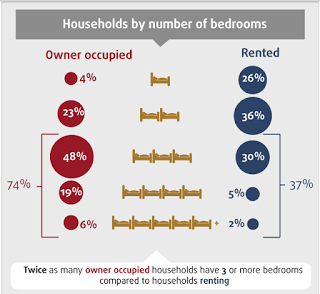Because freeholders do not pay compensation, as tax, for their right to exclude others from valuable locations, they are in receipt of an implicit State subsidy worth around £200bn per year. Not only does this get capitalised into selling prices and rental income, but will lead to misallocation and over consumption of immovable property.
It is reported that the UK has over a million more dwellings than households, and twenty five million empty bedrooms. How many of these are over consumed due to freeholder subsidy? Lets try doing some maths to find out.
 Across England and Wales the average household size was 2.4 people. This figure was the same for owner occupied, but lower for rented households at 2.3 people.
Across England and Wales the average household size was 2.4 people. This figure was the same for owner occupied, but lower for rented households at 2.3 people.Looking in more detail, the average household size was lowest among those households owned outright, at 2.0 people per household. This may in part be explained by the residents being older, with some members of the family having moved out, or a pensioner living alone.
The above graphic and text was taken from the ONS Home ownership and renting in England and Wales – Detailed Characteristics
From it we can extrapolate that for every 100 owner occupied households 300 bedrooms are consumed but for every 100 rented households only 218.
So if we factor in 0.1 more people per household on average for owner occupiers, freeholder subsidy causes the over consumption of 11.8 million bedrooms in England and Wales alone. Or the equivalent of 3.9 million three bedroom houses.
Of course the assumption that a land value tax would rationalise that number of bedrooms is based on the fact that by levelling the field for all participants in the housing market, their housing consumption preferences would all be the same. I personally don't see why they would be significantly different.At the very least, it appears that by allowing an LVT to match supply with demand, the UK has more than enough housing to cover any changes in population or household make up for the foreseeable future.
